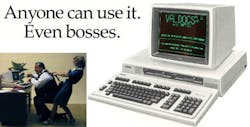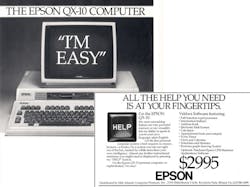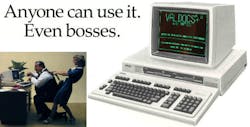Some of you may have received an email recently about the 2014 nominees for the Electronic Design Engineering Hall of Fame. Last year we inducted people like Bjarne Strostrup (see “Bjarne Stroustrup: C++ Creator Keeps Developing”) and Thompson, Ritchie and Kernighan (see “Thompson, Ritchie, And Kernighan: The Fathers Of C”).
Many of the names on this year's list can be found on Wikipedia and may be familiar to many depending upon your background and interest. One may be a little harder to locate though. That is Roger Amidon. If you search Wikipedia for the name then you will find a Roger Amidon born in 1614. That's not him. Add the word VALDOCS and you will find the Epson QX-10 (Fig. 1) entry that provides a little background.
I actually worked for Roger and Chris Rutkowski on VALDOCS (Valuable Documents) at Rising Star Industries. I got the party a little late after the first version was out but stayed through the end when Rising Star closed down. Some of the write ups complained about performance and bugs and they were valid for the first version. The subsequent versions were much more robust.
Chris Rutkowski came up with the idea for VALDOCS that included the HASCI keyboard (Human Application Standard Computer Interface). This had dedicated function buttons like Mail and it even had an UNDO key. The keyboard was integral to the design because switching between the applications was just a matter of clicking a button. VALDOCS contained all the packages like the WYIWYG editor, spreadsheet, mail program and more. It was designed for the average user (Fig. 2).
VALDOCS ran on an operating system called TPM III that Roger had developed over the years. He was involved in a number of companies and software projects back when S100 bus systems were the big thing. Remember, this is pre-IBM PC days. Some may remember Gary Kildall (see “Gary Kildall”) and Digital Research that had an operating system called CP/M.
Roger also developed Zapple, an S-100 bus debugger, as well as TDL (Technical Design Labs) BASIC and a macro assembler. The latter was one I used on the VALDOCS mail program that ran in the background, used protocols like MODEM7 and connected via modems. I don't think you can even find one of those now.
Roger was also involved with hardware design. TDL sold products like a 16K (byte) Low Power Memory card.
Probably the high point for Rising Star and VALDOCS was the 1984 National Computer Conference (NCC). That may be another show many of you have never heard of. It is long gone as well. CBS did a video on the company. It was called “A Gathering of Magicians”.
I would agree that it was a magical time having been there. Roger had a number of challenges. We were one of the first truly distributed companies. The majority of programmers worked from home and there were actually two teams. One on the east coast where Roger was located that handled the system and some of the applications like the mail program I worked on. The west coast group handled most of the applications like the spreadsheet and text editor.
Underneath, the system and some applications like Mail were written in macro assembler. That thing called C wasn't really available. The other applications were written in Forth. I actually worked on the Valdraw drawing program that was written in Forth so I saw both sides of the system. The amazing thing was it was all packed into a floppy disk system that pushed the hardware past its limits.
These days we are used to copy and pasting between applications but back then you were lucky to have one program that would do one job for you. VALDOCS actually let you create a WYSIWIG document and have it sent off in the background by pressing the Mail button on the HASCI keyboard. It was a system designed for non-techies.
VALDOCS and the QX-10 succeeded and received very good reviews from those that were new to computers. It had a logging system so if you turned off the computer the document you were working on would have been saved. It could incorporate drawings into a document and properly print what you saw on the screen. The design took into account the printer capabilities and limitations but VALDOCS tended to take better advantage of the printers than other products at the time.
Eventually Rising Star closed and the versions of VALDOCS we were working on at the time never made it to the public. Like many start ups, there were many factors in play and in this case it was not the technical side that was the major issue. Roger and the crew from Rising Star went onto other things and I eventually wound up here at Electronic Design.
I am always amazed when I hear from others of that era about things like TDL, TPM and S-100 systems. Many went on to build other computers, the Internet and the environment we know now. Few developers appreciate the limitations we worked under like needing a floppy disk for the assembler and linker and another for your code. It was fantastic when we got our hands on the Seagate ST-506 with a whopping 5 Mbytes of storage.
VALDOCS may not be a household name these days but its functionality at the time was what others were comparing new systems with. In many ways it was like the Apple building on Xerox's work.
So if you received one of those emails and think, like I do, that Roger should be acknowledged for his contribution to the computer industry, then include him in the list of your selections for this year's inductees.
About the Author
William Wong Blog
Senior Content Director
Bill's latest articles are listed on this author page, William G. Wong.
Bill Wong covers Digital, Embedded, Systems and Software topics at Electronic Design. He writes a number of columns, including Lab Bench and alt.embedded, plus Bill's Workbench hands-on column. Bill is a Georgia Tech alumni with a B.S in Electrical Engineering and a master's degree in computer science for Rutgers, The State University of New Jersey.
He has written a dozen books and was the first Director of PC Labs at PC Magazine. He has worked in the computer and publication industry for almost 40 years and has been with Electronic Design since 2000. He helps run the Mercer Science and Engineering Fair in Mercer County, NJ.
- Check out more articles by Bill Wong on Electronic Design
- Bill Wong on Facebook
- @AltEmbedded on Twitter


